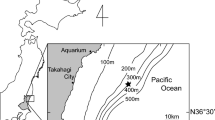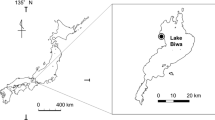Abstract
Spined loaches, Cobitis spp., have been studied in broad fields of research. Particularly, this taxon has attracted attention because of sexual interactions, such as reproductive interference and hybrid speciation, among species. Nevertheless, knowledge of the reproductive behaviors of this genus has been limited to findings from visual observations of aquarium-resident individuals. For this study, we shot videos and analyzed reproductive behaviors of Cobitis magnostriata in the field. We also investigated cues used by males to track females. Based on our observations conducted at a ditch near the shore of Lake Biwa during May–June, 2020, the sequence of courtship and spawning behaviors was divided into four phases: phase 1, a male tracks a female; phase 2, the male swims parallel to a female; phase 3, the male wraps the posterior part of the female’s body from her dorsal fin and remains motionless; phase 4, after the male wraps the female tighter, the female vibrates to spawn. Additionally, we demonstrated that water vibrations initiate the male tracking behavior (phase 1). The adoption of such a non-species-specific cue might be one reason for which the sexual interspecific interactions have been widely reported in this genus.
Access this article
We’re sorry, something doesn't seem to be working properly.
Please try refreshing the page. If that doesn't work, please contact support so we can address the problem.

available at the Movie Archives of Animal Behavior (http://www.momo-p.com/index.php?movieid=momo220119cm02b)





Similar content being viewed by others
Data availability
The datasets generated or analyzed during the current study are available from the corresponding author on reasonable request.
References
Abe T, Kobayashi I, Kon M, Sakamoto T (2007) Spawning behavior of the kissing loach (Leptobotia curta) in temporary waters. Zool Sci 24:850–853. https://doi.org/10.2108/zsj.24.850
Bohlen J (1999) Reproduction of spined loach, Cobitis taenia, (Cypriniformes; Cobitidae) under laboratory conditions. J Appl Ichthyol 15:49–53. https://doi.org/10.1046/j.1439-0426.1999.00122.x
Bohlen J (2000) Similarities and differences in the reproductive biology of spined loach (Cobitis and Sabanejewia) under laboratory conditions. Folia Zool 49(Supplement 1):179–186
Bohlen J (2008) First report on the spawning behaviour of a golden spined loach, Sabanejewia vallachica (Teleostei: Cobitidae). Folia Zool 57:139–146
Bohlen J, Ráb P (2001) Species and hybrid richness in spined loaches of the genus Cobitis (Teleostei: Cobitidae), with a checklist of European forms and suggestions for conservation. J Fish Biol 59:75–89. https://doi.org/10.1111/j.1095-8649.2001.tb01380.x
Brattli MB, Egeland TB, Nordeide JT, Folstad I (2018) Spawning behavior of Arctic charr (Salvelinus alpinus): spawning synchrony, vibrational communication, and mate guarding. Ecol Evol 8:8076–8087. https://doi.org/10.1002/ece3.4277
Caro T (2007) Behavior and conservation: a bridge too far? Trends Ecol Evol 22:394–400. https://doi.org/10.1016/j.tree.2007.06.003
Côté IM (2003) Knowledge of reproductive behavior contributes to conservation programs. In: Festa-Bianchet M, Apollonio M (eds) Animal behavior and wildlife conservation. Island Press, Washington, D.C., pp 77–92
Genner MJ, Young KA, Haesler MP, Joyce DA (2008) Indirect mate choice, direct mate choice and species recognition in a bower-building cichlid fish lek. J Evol Biol 21:1387–1396. https://doi.org/10.1111/j.1420-9101.2008.01558.x
Gröning J, Hochkirch A (2008) Reproductive interference between animal species. Q Rev Biol 83:257–282. https://doi.org/10.1086/590510
Halačka K, Vetešník L, Mendel J, Papoušek I (2010) Can spawning marks on females of the spined loach (Cobitis sp., Teleostei) be caused by scratches from males during mating? Folia Zool 59:329–331. https://doi.org/10.25225/fozo.v59.i4.a9.2010
Janetos AC (1980) Strategies of female mate choice: a theoretical analysis. Behav Ecol Sociobiol 7:107–112. https://doi.org/10.1007/BF00299515
Janko K, Bohlen J, Lamatsch D, Flajšhans M, Epplen JT, Ráb P, Kotlík P, Šlechtová V (2007) The gynogenetic reproduction of diploid and triploid hybrid spined loaches (Cobitis: Teleostei), and their ability to establish successful clonal lineages—on the evolution of polyploidy in asexual vertebrates. Genetica 131:185–194. https://doi.org/10.1007/s10709-006-9130-5
Kano Y, Kitamura J, Kawamura K (2010) Spawning ecology and schemes for the conservation of an endangered cryprinid, Pseudorasbora pumila subsp. sensu Nakamura (1969), including comparisons with a related species, Pseudorasbora parva. Jpn J Ichthyol 57:43–50. https://doi.org/10.11369/jji.57.43
Ko MH, Park SY, Bang IC (2012) Egg development and early life history of Korean spined loach, Iksookimia koreensis (Pisces: Cobitidae). Korean J Ecol Environ 45:93–101
Kottelat M (2012) Conspectus cobitidum: an inventory of the loaches of the world (Teleostei: Cypriniformes: Cobitoidei). Raffles Bull Zool Suppl 26:23–30
Kuno E (1992) Competitive exclusion through reproductive interference. Res Popul Ecol 34:275–284. https://doi.org/10.1007/BF02514797
Kwan YS, Ko MH, Won YJ (2014) Genomic replacement of native Cobitis lutheri with introduced C. tetralineata through a hybrid swarm following the artificial connection of river systems. Ecol Evol 24:1451–1465. https://doi.org/10.1002/ece3.1027
Lodi E, Malacarne G (1990) Reproductive behavior of the spined loach Cobitis taenia L. (Pisces Cobitidae). Ann Des Sci Nat Zool Et Biol Anim 11:107–111
Lodi E, Malacarne G (1991) Differences in sexual behaviour between two phenotypic states of the spined loach, Cobitis taenia L. J Fish Biol 38:321–323. https://doi.org/10.1111/j.1095-8649.1991.tb03120.x
Medina LM, Garcia CM, Urbina AF, Manjarrez J, Mayoho A (2013) Female vibration discourages male courtship behaviour in the Amarillo fish (Girardinichthys multiradiatus). Behav Process 100:163–168. https://doi.org/10.1016/j.beproc.2013.09.007
Minamori S (1956) Physiological isolation in Cobitidae. IV. Speciation of two sympatric races of Lake Biwa of the striated spinous loach. Jpn J Zool 12:89–104
Ministry of the Environment Government of Japan (2020) Red list 2020, Ministry of the Environment, updated 27 May 2020. https://www.env.go.jp/press/107905.html. Accessed 24 May 2021
Miuchi Y (2018) Spawning habitat of Japanese eastern spined loach, Cobitis sp. BIWAE type C in a river. Izunuma-Uchinuma Wetl Res 12:73–78. https://doi.org/10.20745/izu.12.0_73
Morii K, Takakura KI (2018) Age class structure of spawning populations of two endangered endemic striated spined loaches in Lake Biwa river system. Jpn J Environ Entomol Zool 29:135–141. https://doi.org/10.11257/jjeez.29.135
Morii K, Nakano M, Nishida T, Takakura KI (2018a) Growth patterns of juveniles observed at a shared spawning site in two closely related species of spined loaches endemic to the Lake Biwa riverine system: Cobitis magnostriata and C. minamorii oumiensis. Jpn J Environ Entomol Zool 29:49–55. https://doi.org/10.11257/jjeez.29.49
Morii K, Nakano M, Takakura KI (2018b) Does simultaneous and sympatric reproduction between two native spined loaches lead to reproductive interference and local extinction? Environ Biol Fish 101:1407–1416. https://doi.org/10.1007/s10641-018-0787-2
Nakajima J (2012) Taxonomic study of the Cobitis striata complex (Cypriniformes, Cobitidae) in Japan. Zootaxa 3586:103–130. https://doi.org/10.11646/zootaxa.3586.1.11
Nagae K, Takahashi H, Endo H (2021) Mating behavior and early development of Cobitis sp. BIWAE type D. Jpn J Ichthyol 68:143–150. https://doi.org/10.1136/jji.21-007
Nakajima J, Uchiyama R (2017) Loaches of Japan. Yama-kei Publishers, Tokyo
Nakano M, Uehara K, Urabe M (2015) Habitat and breeding season of striated spined loaches on the northwest coast of Lake Biwa. Jpn J Conserv Ecol 20:49–58. https://doi.org/10.1896/hozen.20.1_49
Real L (1990) Search theory and mate choice. I. Models of single-sex discrimination. Am Nut 136:376–404. https://doi.org/10.1086/285103
Robotham PWJ (1977) Feeding habits and diet in two populations of spined loach, Cobitis taenia (L.). Freshw Biol 7:469–477. https://doi.org/10.1111/j.1365-2427.1977.tb01696.x
Rowe S, Hutchings JA (2003) Mating systems and the conservation of commercially exploited marine fish. Trends Ecol Evol 18:567–572. https://doi.org/10.1016/j.tree.2003.09.004
Saitoh K (1990) Reproductive and habitat isolation between two populations of the striated spined loach. Environ Biol Fish 28:237–248. https://doi.org/10.1007/BF00751037
Saitoh K, Matsuda S (1990) Spined loaches distributed in the Lake Biwa water system. Annu Rep Biwako Bunkakan 8:19–23
Saitoh K, Chen WJ, Mayden LR (2010) Extensive hybridization and tetrapolyploidy in spined loach fish. Mol Phylogenet Evol 56:1001–1010. https://doi.org/10.1016/j.ympev.2010.04.021
Satou M, Shiraishi A, Matsushima T, Okumoto N (1991) Vibrational communication during spawning behavior in the himé salmon (landlocked red salmon, Oncorhynchus nerka). J Comp Physiol A 168:417–428. https://doi.org/10.1007/BF00199602
Takeno M, Kashiwagi S, Kitagawa T (2010) A distinctive allotetraploid spined loach population (genus Cobitis) from Tango District, Kyoto Prefecture, Japan. Jpn J Ichthyol 57:105–112. https://doi.org/10.11369/jji.57.105
Wildhaber ML (2008) The role of reproductive behavior in the conservation of fishes: examples from the great plains riverine fishes. Am Curr 34:16–23
Acknowledgements
We deeply thank Kazuo Uehara for his management of this study site. We also thank Jun Nakajima for his valuable advice about this study. All surveys comply with current laws of the country in which they were administered.
Funding
This study was funded by JSPS KAKENHI (Grant numbers KB19J23611).
Author information
Authors and Affiliations
Contributions
KM and KIT designed this study and analyzed the data. KM performed field observations to collect data. KM and KIT prepared the manuscript.
Corresponding author
Ethics declarations
Conflict of interest
The authors declare that they have no conflict of interest.
Ethical statement
The Animal Care and Use Committee for The University of Shiga Prefecture, the institute to which the authors belong, requires no approval of the study plans that use fishes. Therefore, this study has no approval number from the Committee but it was conducted with the most careful attention to the degree that it meets with the category “experiments that are expected to produce little or no discomfort” of the guidelines of the Committee.
Additional information
Publisher's Note
Springer Nature remains neutral with regard to jurisdictional claims in published maps and institutional affiliations.
Supplementary Information
Below is the link to the electronic supplementary material.
About this article
Cite this article
Morii, K., Takakura, KI. Reproductive behavior of endangered spined loach Cobitis magnostriata in the field. J Ethol 40, 167–174 (2022). https://doi.org/10.1007/s10164-022-00746-1
Received:
Accepted:
Published:
Issue Date:
DOI: https://doi.org/10.1007/s10164-022-00746-1




